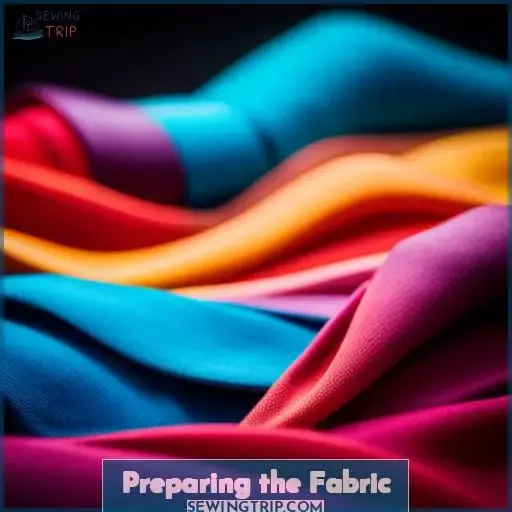This site is supported by our readers. We may earn a commission, at no cost to you, if you purchase through links.
 You want to paint your own unique designs on cotton fabric, but have no idea where to start. The blank canvas taunts you, contrasting the boundless creativity in your mind. While intimidating at first, painting cotton is easier than you think with the right supplies and techniques.
You want to paint your own unique designs on cotton fabric, but have no idea where to start. The blank canvas taunts you, contrasting the boundless creativity in your mind. While intimidating at first, painting cotton is easier than you think with the right supplies and techniques.
Forget meticulous measurements and perfectly straight lines – this DIY project liberates your inner artist.
Equip yourself with fabric paint and embrace trial-and-error to unlock mastery. We’ll prep the fabric so acrylics adhere permanently. Sketch boldly, paint gently, set thoroughly. Your painted cotton will be a wearable work of art if you follow a few simple steps.
Let your imagination run wild on cotton! Making mistakes here leads to better techniques, not failure. Once you know how to prep the fabric, sketch a design, and properly apply pigments, you’ll create breathtaking painted cotton.
Don’t overthink it! Start with an abstract shape or scribble. Painting cotton is about freedom. Follow our tips to prepare, design, and set the fabric paint for a foolproof process.
Table Of Contents
Key Takeaways
- Start with the right supplies and choose paint based on lightfastness, versatility, application method, and washability.
- Pre-wash the fabric and use a barrier to prevent paint bleed-through.
- Lightly sketch the design before painting and use tape for clean edges.
- Heat set acrylic paint, experiment with mediums, and properly care for the painted fabric.
Choosing Fabric Paint
When painting cotton fabric, first consider acrylic paint versus fabric dye and the pigments or inks you’ll use. Focus on lightfastness, versatility, application method, and washability as you choose paints for your project.
Keep in mind the fiber content of the material and your desired end result. Consider the pros and cons of different paint types for cotton. Acrylic paint is versatile, easy to use, and available in many colors, but it stiffens fabric.
Fabric dye offers brilliant colors and won’t stiffen fabric, but it requires heat setting. Pigment inks create vivid hues without stiffening, but may fade over time. Properly preparing the fabric and using textile mediums with acrylics can help maintain drape.
Test samples first to ensure the paints withstand laundering if needed. Selecting the right painting materials for cotton can help you achieve beautiful, durable results.
Acrylic Vs. Fabric Dye
When choosing paint for cotton, you’d be wise to think twice before automatically grabbing those pretty acrylics, because fabric dye will make your designs far more vibrant and long-lasting. Though acrylics boast durability after heat setting, fabric dyes excel in color vibrancy and suit cotton’s thirsty fibers best.
Test paints on swatches first to ensure colorfastness before applying to your project. With the proper preparation and the right paint for your fabric, you’ll craft designs that will turn heads.
Pigments and Inks
For fabric painting, you’ll want pigments and inks that flow smoothly yet dry permanent on your cotton material. When mixing pigments, test compatibility on swatches first. Prepare fabric so paint adheres.
Gently blend inks for seamless transitions. Check consistency as some inks thicken over time. Let layers dry fully between applications for crisp results. With quality pigments and smart preparation, you’ll achieve stunning fabric paintings.
Preparing the Fabric
Before starting your cotton fabric painting project, you’ll want to pre-wash your fabric to remove any dirt, chemicals, or fabric finishes that could prevent the paint from properly adhering. Next, attach a barrier like freezer paper or a plastic bag between the front and back of the fabric so the paint only seeps through to one side.
This will help stop the paint bleeding through to the other side. Make sure to smooth out any wrinkles or folds in the fabric before you start painting. You may want to iron the fabric if needed. It’s also a good idea to lay down an old sheet or some newspaper under your work area to protect your table or floor from spills and splatters.
Pre-wash
You’ll want to pre-wash your cotton fabric before painting to remove any dirt, sizing, or chemicals. This step prepares the surface and helps the paint better adhere. Use warm water and a mild detergent, then rinse thoroughly.
Skipping pre-washing risks poor paint adhesion and uneven color. For the best fabric painting results, always pre-wash cotton to remove contaminants so the colors pop.
Attach Barrier
Attach a barrier between layers for defined edges and to prevent bleed through.
- Use freezer paper with the shiny side down as a temporary barrier.
- Attach it smoothly with a warm iron to create clean paint edges.
- Cut stencils from cardstock for blocking specific areas from paint.
- Place painter’s or masking tape between fabric layers to prevent seepage.
- Insert cardboard between the front and back sides as a shield from saturation.
With the right materials secured, you’re ready to begin designing custom fabrics without limitations. Discover your artistic voice through fabric painting techniques for beautiful results.
Design and Sketch
Let’s get started creating your design on the cotton fabric. Tape off sections of the fabric where you want to apply certain colors, then lightly sketch your design in pencil directly on the fabric so you have guide lines to follow when painting.
The pencil lines will allow you to visualize the finished piece before applying paint.
Tape Off Sections
Come rain or shine, tape off sections to piece your vision into place. Use painter’s tape for crisp edges when coloring separate shapes; it peels away without residue, unlike masking tape. Tape off areas and create custom patterns for color blocking, textures, and blending paints.
With precision, paint bold designs within sections using fabric markers or paint pens. Plan ahead and tape with purpose to avoid bleeding under edges. Experiment with geometric designs and bold stripes.
By taping off creative shapes on fabric, eye-catching pieces emerge from your imagination.
Pencil on Design
Lay out your vision with a sketch before permanently marking the fabric. Lightly draw the design with a pencil directly on the prepped cotton. Start with the outline shapes for your creative pattern. Envision color blending, texture effects, stencil shapes before adding vivid pigment.
Make adjustments and refine details in this planning stage. Sketching first allows experimenting without commitment. It’s crucial for executing your fabric painting technique and realizing your design inspiration on the cotton canvas.
Painting Techniques
When painting cotton fabric, the gentle and even application of paint is crucial. Allow adequate drying time between coats to prevent smearing and achieve the desired results.
Gentle, Even Application
Disperse the paint evenly across the surface for the best results. When blending colors, use gentle brush techniques for smooth coverage. Adjust paint consistency if needed for your fabric texture. Moving the brush in different directions creates an even application.
Dampening the fabric first allows colors to spread smoothly. With a light touch, you can layer and blend hues across the cotton to achieve your desired effect.
Allow Drying Time
Slather on the acrylics and let each layer dry properly before adding the next, or your work may run into a muddled mess. After applying paint, allow at least 24 hours for drying time before heat-setting or washing the fabric.
Work in a well-ventilated area, as alcohol-based pigments require extra drying time. Check thickness by gently touching paint – if it’s still tacky, more drying is needed.
Setting the Paint
After it dries, heat set your acrylic paint on cotton to make it permanent. Heat setting helps the paint bond to the fabric fibers for durability.
Set the paint by ironing the fabric between parchment paper or an old towel. Use a medium heat setting and avoid direct contact between the iron and painted fabric.
Iron over the surface for 2-3 minutes. Let it cool, then check for any tackiness.
The heat helps the acrylic fully cross-link and bind to the cotton. This is essential for color fastness through washing.
Correcting Mistakes
You can correct painting mistakes on cotton fabric, but proceed carefully. Experiment with using small amounts of bleach to lighten stains and try stencils or adding mediums to enhance your overall design.
Using Bleach
You’ll need to cautiously apply the bleach for correcting mistakes on your cotton painting.
- Test bleach on an inconspicuous area first.
- Dilute bleach to avoid over-bleaching.
- Apply with a cotton swab for targeted lightening.
- Rinse thoroughly after 1-3 minutes at most.
With bleach, a little goes a long way for correcting cotton fabric painting errors. Start with a weak dilution and gradually increase the bleach strength as needed. Targeted application allows strategic lightening without overdoing it. Rinsing quickly prevents damage.
Experimenting With Mediums
Experimenting with Mediums
Create unique effects by mixing mediums into your cotton fabric paints. Blend acrylic paint with textile mediums like softener, thickener, or glazing liquid before applying to fabric. This allows you to create custom textures, transparencies, and surface finishes.
Experiment by layering mediums over painted cotton for dimensional effects. Mixing mediums with fabric paint unlocks unlimited potential for innovative techniques, captivating color, and tantalizing texture when decorating cotton.
Caring for Painted Fabric
Let’s keep your painted cotton lively by line drying out of direct sunlight and washing gently in cold water. When caring for painted fabric, avoid using hot water or fabric softeners, which can cause fading.
For stain removal, immediately treat any spills with a damp cloth rather than vigorously rubbing.
Limit sunlight exposure, as UV rays will diminish vibrancy over time. For hand washing, use a mild detergent and fully rinse with cool water before line drying.
When ironing, set your iron to a low-heat cotton setting and avoid ironing directly on top of painted areas. With a few easy precautions, your hand-painted cotton will maintain its color and design through many wears and washes.
Conclusion
Fabric painting is an exciting and creative way to add a personal touch to your wardrobe. With the right fabric paint, preparation, and technique, you can create beautiful and unique designs on cotton fabric.
As long as you remember to pre-wash, attach a barrier, and apply the paint gently, you’ll be able to create stunning pieces that will last for years.
Additionally, if you make a mistake, you can safely use bleach and other mediums to fix them. To ensure your fabric paint lasts, use acrylic paint and set it with heat and specific washing instructions.
With these tips and tricks, you can confidently start painting cotton fabric and have fun creating your own unique designs.













